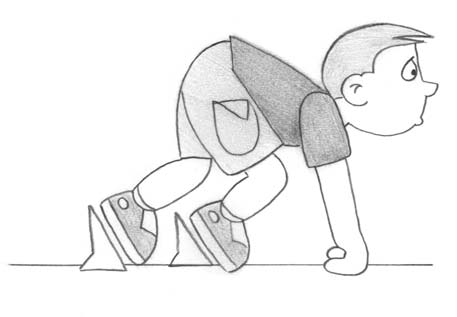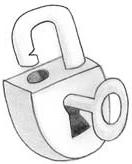The 1-2-3 Magic Workbook for Christian Parents: Effective Discipline for Children 2-12 (20 page)
Read The 1-2-3 Magic Workbook for Christian Parents: Effective Discipline for Children 2-12 Online
Authors: Thomas W. Phelan,Chris Webb
Tags: #Family & Relationships, #Parenting, #General

108 1-2-3 MAGIC
love you or that they are bound to grow up to become inmates in a federal
penitentiary. Lying is a problem, though, and it needs to be managed care-
fully and thoughtfully. Over the years, frequent emotional overreactions
from you—combined with badgering and cornering—can help produce
an Accomplished Liar.
Congratulations! You have just learned parenting Step 1: Control-
ling Obnoxious Behavior. You are ready to begin counting and you are
prepared for testing and manipulation from your kids. So now we’re on
to the next giant parenting step: Encouraging Good Behavior.
Points to Remember
1. A principal goal of the Major/Minor System is the
prevention of bigger behavior problems later on.
2. Many parents won’t ever need to use this part of the program.
3. Use the Major/Minor for more serious problems, such as stealing,
bullying, property damage, hours violations and lying.
4. When implementing consequences, be decisive and—although
it’s very hard—be as calm and reasonable as you can!
Part IV
Encouraging
Good Behavior

13
7 Start-Behavior Tactics
Scientists discover room-cleaning gene on chromosome 16!
Now we turn our attention to the second big parenting step: encour-
aging your children
to
do the positive things you want them to do.
We call this behavior category Start behavior, because you want your
children to
start
doing their schoolwork, going to bed, eating their supper,
cleaning their rooms and getting up and out in the morning.
Recall that Start behavior requires more motivation from children
than Stop behavior. While it may only take one second to stop whining
or arguing, tasks such as doing homework or getting up and off to school
may require thirty minutes or more. Kids not only have to start these jobs,
they also have to continue and finish them. Counting difficult behavior
is fairly easy. When it comes to positive behavior, however, moms and
dads have to be more skilled motivators.
It’s a good idea, when beginning this program, to use counting first
for a week to ten days before tackling Start behavior.
If you try to do the
whole program at once (both Stop and Start problems), it may be a little
too much to keep straight. Equally important, it will also be considerably
easier to get the kids to do the good things if you have first gotten back in
control of the house by effectively managing their obnoxious conduct.
111

112 1-2-3 MAGIC
When you begin using your Start behavior tactics, don’t be surprised if you
run into testing and manipulation. Remember, your daughter is not going
to thank you for encouraging her to clean her room. If you have worked
on counting negative behavior first, you will have
Key Concepts… had a fair amount of experience in dealing with
Stop behavior, such as testing, before you tackle
With Start behavior,
you can use more
the task of getting the kids to do the good things.
than one tactic So have the 1-2-3 ready in your back pocket; you
at a time for a
can pull that tool out whenever necessary.
particular
There are seven Start behavior tactics you can
problem. You may
even come up with some
consider using. Sometimes you may use just one
of your own strategies.
tactic, but other times you may use two or three
Remember: Train the kids
for the same problem. While counting obnoxious
to do what you want, or
behavior is fairly straightforward, you can be more
keep quiet!
creative and flexible when managing positive
behavior. In fact, many parents and teachers have
come up with useful and imaginative ideas that are not on our list.
Here are our seven strategies for encouraging good behavior:
1. Positive reinforcement
2. Simple requests
3. Kitchen timers
4. The Docking System
5. Natural consequences
6. Charting
7. Counting (different version)
When dealing with Start behavior, keep in mind one of the basic
rules of
1-2-3 Magic
:
Train the children or keep quiet!
In the 1-2-3 program there is a method for handling just about every kind of problem
your kids can throw at you. So use these methods! Kids, for example, are
not born to be natural room cleaners. If the child isn’t cleaning his room,
train him to clean it. Otherwise, be quiet, clean it yourself or close the
door and don’t look. Training, however, does not mean nagging, arguing,
yelling or hitting.
7 START BEHAVIOR TACTICS 113
With these rules in mind, let’s take a look at the seven tactics you will
use to get the kids to do what they’re supposed to.
1. Positive Reinforcement
Angry people make noise; happy people remain silent. We all suffer from
a biological curse that motivates us to say something to our kids when
we’re angry at them, but to keep quiet when the little ones are doing what
we want them to do. Imagine it’s a Sunday in October and I’m watching
a football game in the afternoon. My two children are in the next room
playing a game with each other, having a great time and getting along very
well. What do you think the chances are that I’m going to get up out of my
chair, walk all the way into the next room, and say, “Gee, I’m delighted
you guys are having such a good time!”? That would be a great thing, but
the chances of my doing it are about zero. Why? Because when adults
are happy and content themselves, they are not particularly motivated to
do anything more than what they’re already doing.
But imagine that my children in the next room start fighting and
screaming. Why do they behave this way?! I can’t even hear the football
game!! Now I am motivated—I’m mad. Now the chances of my getting
up, running into the other room and yelling at the kids to keep quiet are
high. Anger is a much better motivator than contentment. The result is
that our kids are more likely to hear from us when we have negative rather
than positive feedback. Youngsters as well as spouses can start feeling
they’re just a pain in the neck to us.
One powerful antidote to this unfortunate biological orientation inside
us is praise, or positive verbal reinforcement. As the saying goes about
voting in Chicago, praise should be done early and often. Your praise
and other positive interactions with your kids should outnumber your
negative comments by a ratio of about three or four to one. If you look,
you shouldn’t have trouble finding something to reinforce:
“Thanks for doing the dishes.”
“You started your homework all by yourself!”
“That dog really likes you.”
“You kids did a good job of getting along during the movie.”

114 1-2-3 MAGIC
“I think you got ready for school in record time this morning!”
“Good job on that math test, John.”
“I saw you out on the soccer field. You played hard—good hustle!”
“That’s wonderful! I can’t believe it! How on earth did you do that?!”
Once you’ve gotten the kids successfully carrying out a particular
Start behavior, positive reinforcement can help keep the cooperation or
good performance going. Many parents, for example, praise or thank their
kids for complying with simple requests or for
following a bedtime or homework routine.
Quik Tip…
Keep a sensitive eye on your son or daugh-
Praise in front of ter, though, because praise should be tailored
other people and
unexpected praise are
to some extent to each child. Some kids like
potent reinforcers. These
rather elaborate, syrupy and emotional verbal
tactics will make your
reinforcement, while others do not. Your eight-
children feel very proud.
year-old daughter, for instance, gets 100 percent
They’ll really appreciate
you for your thoughtful-
on Wednesday on her spelling pretest. You say,
ness—and they’ll keep up
“Oh Melissa, that’s just marvelous! I can’t
the good work!
believe it! We’re going to frame this paper and
also fax it to grandma in Florida!!” Melissa eats
it up. Melissa’s eleven-year-old brother, however, would be nauseated by
that kind of talk. For him, “Good job—keep up the good work,” and a
pat on the shoulder might be enough. Your job is to praise the child, not
to embarrass him.
There are two additional devices you can use to make praise a more
effective boost to a child’s self-esteem: (1)
praise in front of other people
and (2)
unexpected praise
. While you’re talking to your next door
neighbor, for example, your daughter Kelsey walks up. You interrupt your
conversation and say, “You should have seen Kelsey out there on the
soccer field today. Those other kids never knew what hit them!” Kelsey
will beam with pride.
Unexpected praise can also be quite memorable for a child. Your son
is upstairs doing his homework. You call from the bottom of the stairs,
“Hey, Jordan!” Jordan has no idea what’s coming next. You then say,
“Did I tell you what a great job you did on the yard?” Jordan will be
pleased—and perhaps a little relieved!
7 START BEHAVIOR TACTICS 115
How do you keep offering praise and encouragement on a regular
basis? As mentioned before, this task is surprisingly difficult, since most
of us tend to shut up when we are content. Here are two suggestions. First,
see if you can make two or three positive comments for every one nega-
tive comment (by the way, one count is one negative comment). These
positive remarks don’t have to be made at the same time, of course. They
can be made later. If the two-or-three-to-one ratio idea doesn’t appeal to
you, a second strategy is to have a quota system. Each day you make a
deal with yourself that you will make at least five positive comments to
each child (consider doing the same with your spouse).
2. Simple Requests
The problem with simple requests is that they are not so simple. Parental
requests to children can be made more or less effective by the parent’s tone
of voice, the spontaneity of the request and the phrasing of the demand.
We all have different voices. When she was younger, my daughter